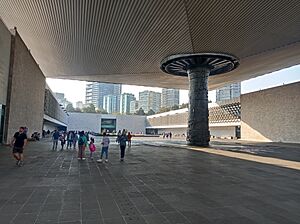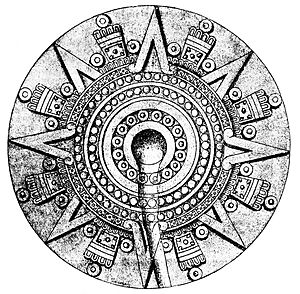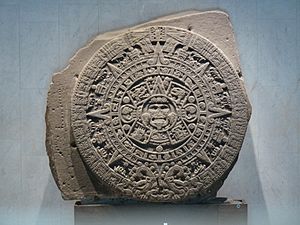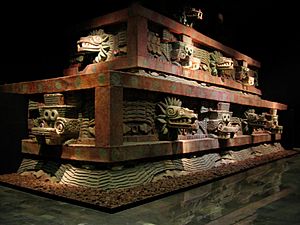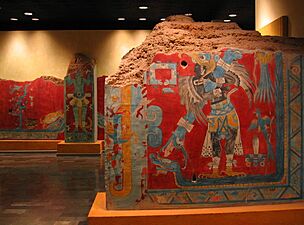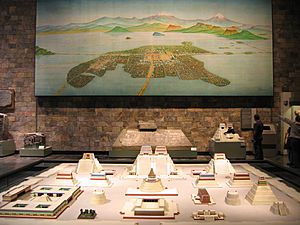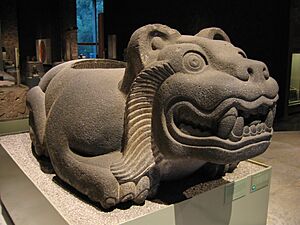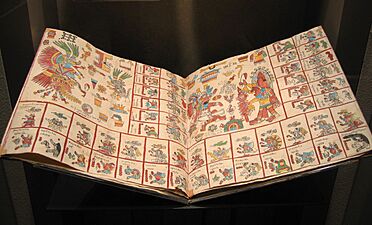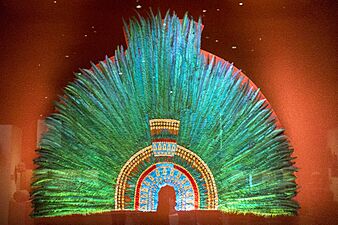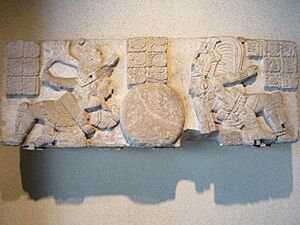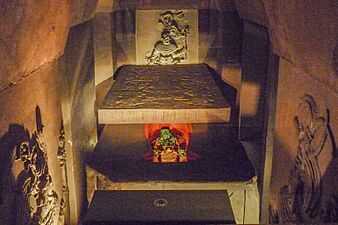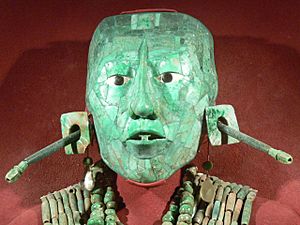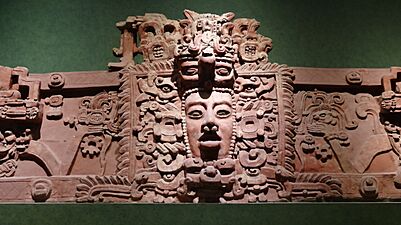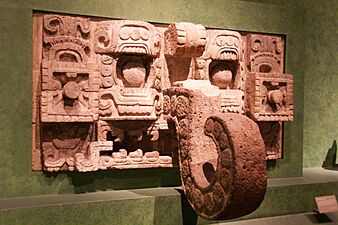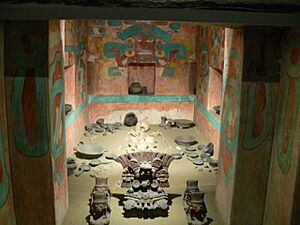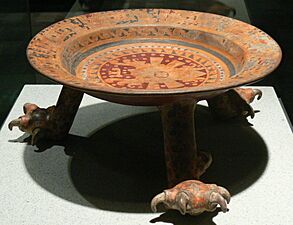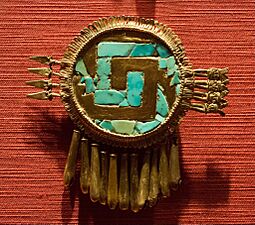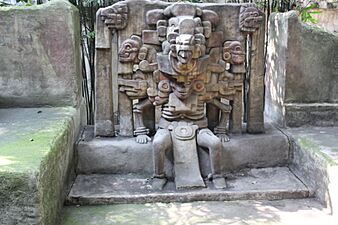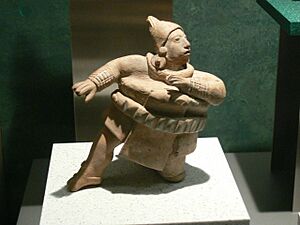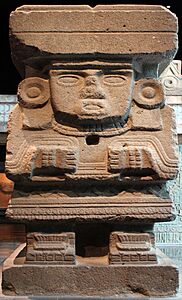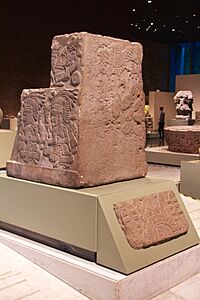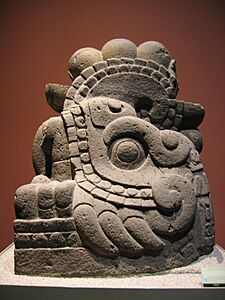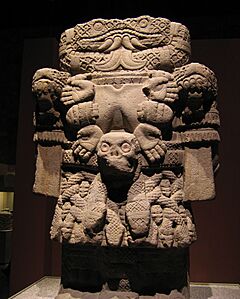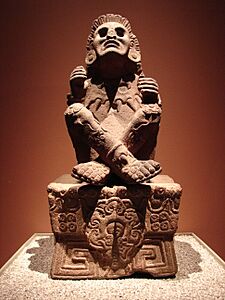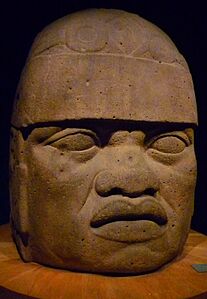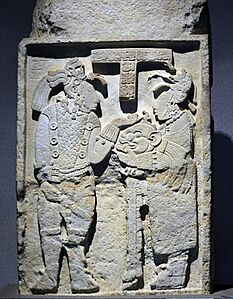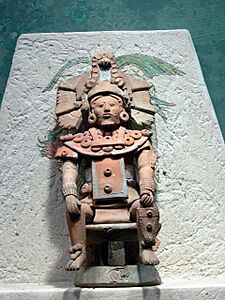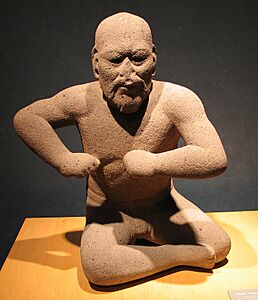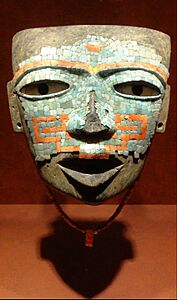National Museum of Anthropology (Mexico) facts for kids
| Museo Nacional de Antropología (Spanish) | |
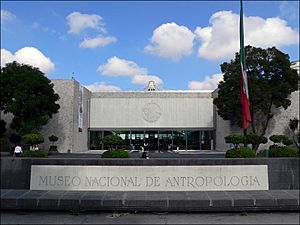
The museum's front entrance in 2006
|
|
| Established | 1964 |
|---|---|
| Location | Mexico City, Mexico |
| Type | Archaeology museum |
| Collection size | 600,000 |
| Visitors | 3,700,000 (2024) |
| Public transit access | Auditorio Station (line 7) |
The National Museum of Anthropology (MNA) is a super important museum in Mexico. It's the biggest and most visited museum in the whole country! You can find it in Mexico City, inside Chapultepec Park. This museum is full of amazing ancient treasures from Mexico's past, like the famous Stone of the Sun (also known as the Aztec calendar stone) and a cool statue of the Aztec god Xochipilli. These items teach us about the people who lived in Mexico long before Europeans arrived.
In 2024, over 3.7 million people visited the museum, making it the most popular museum in Mexico and one of the most visited art museums worldwide! The museum is managed by the Instituto Nacional de Antropología e Historia (INAH). It was officially opened in 1964 by Mexican President Adolfo López Mateos.
Museum Design
The museum building was designed in 1964 by Pedro Ramírez Vázquez, Jorge Campuzano, and Rafael Mijares Alcérreca. It's a huge and impressive building. Inside, there's a large courtyard with a big pond. A giant concrete "umbrella" (called "el paraguas" in Spanish) stands in the middle, supported by a single, thin pillar.
The museum has 23 rooms for exhibits. It covers a massive area of about 79,700 square meters, which is almost 20 acres! Many of the exhibition halls are surrounded by beautiful gardens, and some even have outdoor displays.
A Look at History
The story of this museum began a long time ago, in the late 1700s. Important items, like the sculptures of Coatlicue and the Sun Stone, were gathered. These items formed the first collection of what would become the National Museum of Anthropology.
In 1790, the Cabinet of Curiosities of Mexico was created. Famous scholars, like Alexander von Humboldt, visited the museum in the 1800s. In 1825, Mexico's first president, Guadalupe Victoria, officially established the National Mexican Museum. Later, in 1865, Emperor Maximilian moved the museum to a new location.
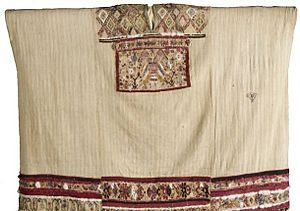
As the museum's collections grew, they were divided. In 1906, the natural history items moved to a different building. The museum was then renamed the National Museum of Archaeology, History and Ethnography. By 1924, it had over 52,000 objects and welcomed more than 250,000 visitors!
In 1940, the museum was divided again. The historical collections moved to Chapultepec Castle to form the Museo Nacional de Historia. This new museum focused on Mexico's history after the Spanish arrived. The remaining collection became the National Museum of Anthropology. It now focused on pre-Columbian Mexico and the cultures of modern Mexican people.
The construction of the current museum building started in 1963. It was built in Chapultepec park. The project was led by architect Pedro Ramírez Vázquez. The building was finished in just 19 months. It opened on September 17, 1964. President Adolfo López Mateos said that the museum was built to honor the amazing ancient cultures of Mexico.
What You Can See
The museum has many incredible things to see. You can find the famous Stone of the Sun here. There are also giant stone heads from the Olmec civilization. These huge heads were found in the jungles of Tabasco and Veracruz.
You can also see treasures found from the Maya civilization at Chichen Itza. There's even a copy of the lid from Pakal's tomb at Palenque. The museum also shows how people live in rural Mexico today. Plus, there's a model of the ancient Aztec capital, Tenochtitlan. This is where modern Mexico City now stands.
The museum's main floor shows all the ancient civilizations that lived in Mexico. These include the North, West, Maya, Gulf of Mexico, Oaxaca, Mexico, Toltec, and Teotihuacan cultures. The upper floor shows the cultures of Native Mexican people since the Spanish arrived.
The museum also brings in special exhibits from other parts of the world. In the past, they have shown artifacts from ancient Iran, Greece, China, Egypt, Russia, and Spain.
Exhibits Gallery
-
Reproduction of the Temple of the feathered serpent in Teotihuacan
-
Mural and model of Tenochtitlan, looking east
-
National Museum of Anthropology - Aztecs (JC) 13.JPG
Skull covered with turquoise
-
Replica of Codex Borbonicus
-
Replica of feather headdress of Moctezuma II
-
Relief of Toniná
-
Reproduction of the mausoleum of the Palenque ruler, K'inich Janaab' Pakal
-
Mask of Chaac
-
Statue of Chalchiuhtlicue
-
Lintel 26, Yaxchilan
-
Ceramic of the Jaina Island
See also
 In Spanish: Museo Nacional de Antropología (México) para niños
In Spanish: Museo Nacional de Antropología (México) para niños


